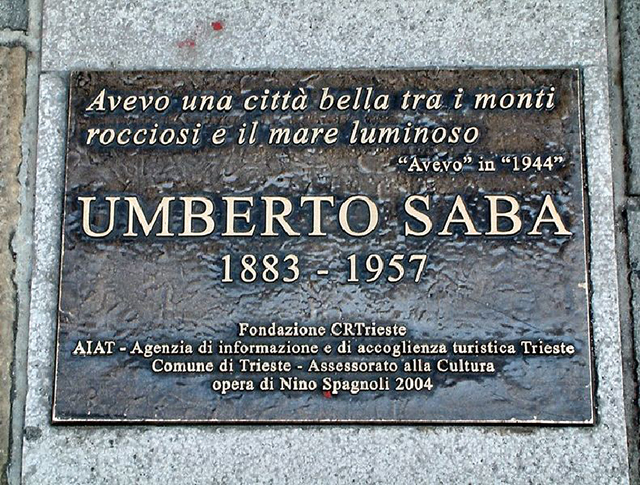1. SABA’S BIRTHPLACE
Via di Riborgo, 25
No longer in place; today corresponds approx. to via del Teatro Romano
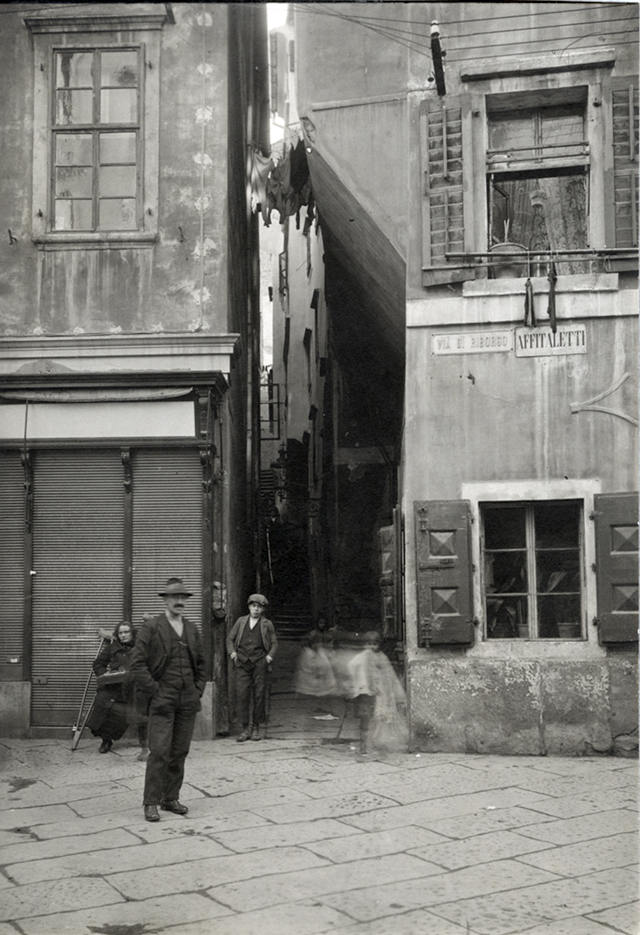
Via di Riborgo started from piazzetta San Giacomo (no longer in place) facing via del Corso (today Corso Italia) and ran through the Jewish ghetto, across fetid streets and run-down buildings with no plumbing and common toilet facilities. Between 1934 and 1938, the fascist regime forced the inhabitants of the ghetto out of their homes and hundreds of buildings were brought down, including Saba’s birthplace. Via di Riborgo was replaced by Corso del Littorio, today via del Teatro Romano.
When I was born my mother wept over it,
alone at night in her empty bed.
For me and for her, being destroyed by grief as she was,
her dear relatives were buying and selling in the ghetto.
– Autobiography (1924)
2. HOUSE OF SABA’S WET NURSE
Via del Monte, 15
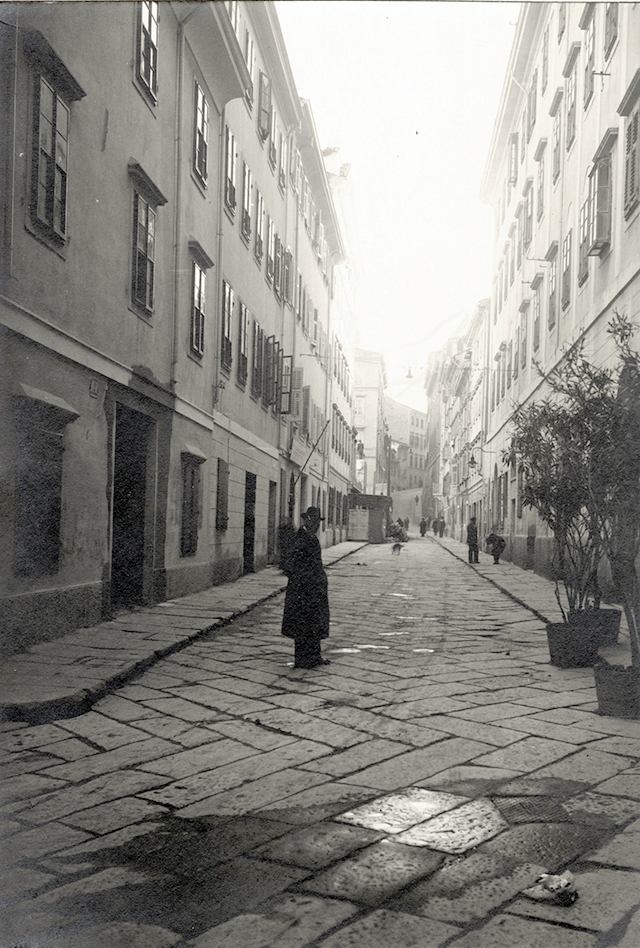
For the first three years of his life Saba was raised by a Slovenian wet nurse, Peppa Gabrovich, who was a Catholic peasant.
Some poems from Il Piccolo Berto (Little Berto) refer to Saba’s pain when his mother suddenly dismissed the nurse, allegedly because she was jealous and because the nurse had tried to raise the baby as a Catholic.
The house of my wet-nurse sits
quietly facing the old Chapel,
and from a hillside where goats love to browse
it gazes down and looks pensive.
– The house of my wet-nurse (1901)
3. SABA’S SECOND HOUSE
Piazzetta San Giacomo, 1
No longer in place, it opened on the corner between via di Riborgo and corso Italia, approx. corresponding today with largo Riborgo
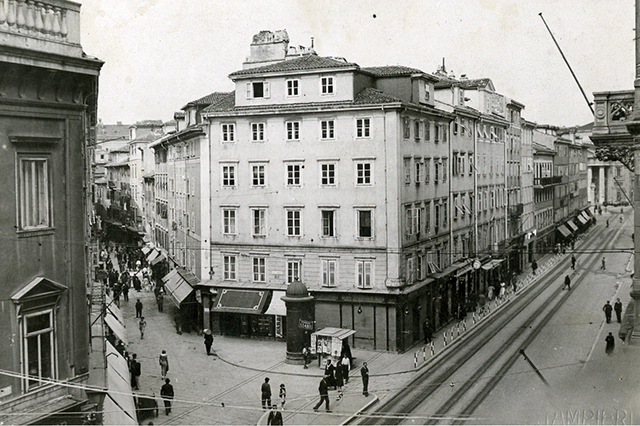
In 1888 Saba and his mother moved in with one of her sisters, aunt Regina, first in via degli Artisti 7 and in 1891 in piazzetta San Giacomo, first at number 3 and later at number 1.
In his poem Dedica a mia zia Regina (To my aunt Regina), 1921, Saba describes his love for this aunt, in spite of her “acute passion for economy and thrift”. Aunt Regina was the only person who showed enthusiasm when reading his poetry and his early short stories and concern for his education. It was thanks to her that in 1903 Saba could study in Pisa. When she died, she left him 100,000 crowns.
Often, so as to make my way home
I take a dark street in the old town.
Here and there the lamplight glitters
yellow in the occasional puddle, and the street is crowded
– Old town (1910-12)
4. HOUSE OF LINA
Via Domenico Rossetti, 28 (today 24)
Saba met his future wife Carolina Wölfler, who lived in via delle Acque 18 (today via Ruggero Timeus 12), in 1904 when one of her cousins introduced her to him. They would not meet again until 1907-1908, after Saba completed his military service. At the time Carolina and her family lived in via Domenico Rossetti, 28 (today 24). Saba, who knew the street where she lived but not the exact number, was walking walk up and down via Rossetti in the hope of seeing her when she appeared at the window to water a vase of geraniums.
Via del Monte is the street of devout sentiments,
but the street of joy and of love
remains Via Domenico Rossetti.
– Three streets (1910-12)
5. JEWISH TEMPLE KNOWN AS SCUOLA VIVANTE
Via del Monte, 3
On 28 February 1909 Umberto Saba took Carolina Wölfler as his wife in the Jewish Temple known as Scuola Vivante, today the seat of the Carlo and Vera Wagner Museum near the ancient Jewish Cemetery at the foot of the hill of San Giusto. In that same year the Jewish remains buried here were ordered to be transferred to the new cemetery in via della Pace since the area was expropriated by the local government to be converted into the Park of Remembrance (Parco della Rimembranza).
In Trieste where there are many sadnesses,
and beauties of sky and country road,
there is a step climb called Via del Monte.
It begins with a synagogue,
and it ends at a cloister.
– Three streets (1910-12)
6. HOUSE OF SABA FROM 1909 TO HIS DEATH
Via Chiozza, 56
today via Francesco Crispi, 56
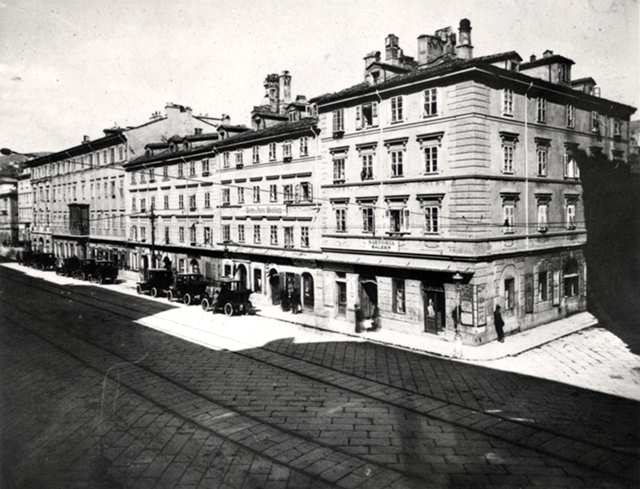
The first house where Saba and his wife Lina lived was located in the countryside near Montebello in Strada di Fiume, probably around number 141.
As Saba himself noted, it was here that he composed A mia moglie (To my wife).
In February 1919, at the end of the war, Saba was discharged from the army and he returned to Trieste, where he moved to via Chiozza, 56 on the second and later the fourth floor.
7. “ITALIA” CINEMA-THEATER
Via Dante Alighieri, 3
Saba had always lived on a private income, but after the war, when Trieste became Italian, the bequeath left by his aunt Regina was no longer enough. Thus in 1919, before opening the antique bookshop, Saba worked for several months at the “Italia” Cinema – Theater managed by his brother-in-law Enrico Wölfler. Here he wrote promotional texts to advertise films.
I love the Sunday crowd here,
that erupts onto itself, and if only
they can find a seat, they sit in admiration to enjoy
a little American optimism.
– Song of Love (Sunday after lunch at the cinema) 1925-1930
8. ANTIQUE BOOKSHOP
Via San Nicolò, 30
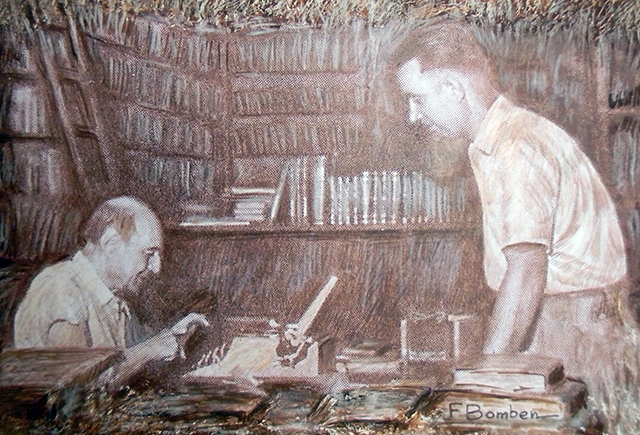
In September 1919 Saba and his friend Giorgio Fano bought for 4,000 liras the second-hand bookshop of Giuseppe Mayländer. Initially they intended to clear the place and sell it to make a profit, but Saba was so deeply fascinated by those old books (more than 28,000) that he talked his friend into reopening as an Antique Bookshop. Saba would work here for more than thirty-five years: in Primavera d’Antiquario (Springtime of an Antique Dealer), 1926, he declared himself to be the “custodian of the noble dead”.
During the Second World War the racial laws forced him to pretend that he had sold his business to Carlo Cerne, his employee since 1924, who would remain his business partner with a fifty percent stake. After Saba’s death, Cerne continued to work at the bookshop that he left to his son Mario, who continues to manage the shop to this day.
I used to have a lovely city set between craggy
mountains and the luminous sea. Mine
because I was born there, more mine than others’
for I discovered It as a boy, and when I grew up
I married it to Italy for ever with my song.
One had to live. And for that
I chose the most dignified of maladies: it was the discreet
little antiquarian bookshop.
The inept Fascist, the guzzling German,
took everything away from me.
– I use to have (1944) –
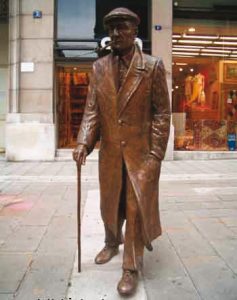
9. STATUE
Via Dante
In 2004 a bronze statue by Nino Spagnoli was erected at the corner of via Dante and via San Nicolò. It portrays Saba walking towards his beloved bookshop. The pipe between his lips – that had been a staple throughout his life – was repeatedly stolen and it was eventually decided not to replace it.
10. WALTER’S CAFE AND DAIRY
Via San Nicolò, 31
The dairy in front of the bookshop was Saba’s favorite place for a break. He could be found at Walter’s several times a day and visitors would stop by and chat with him at the table in the front, near the shop window.
At times, when Saba was composing poetry and needed concentration, Carlo Cerne had to leave the bookshop and stayed at Walter’s until the poet had finished.
11. OFFICE OF EDOARDO WEISS
Via San Lazzaro, 8
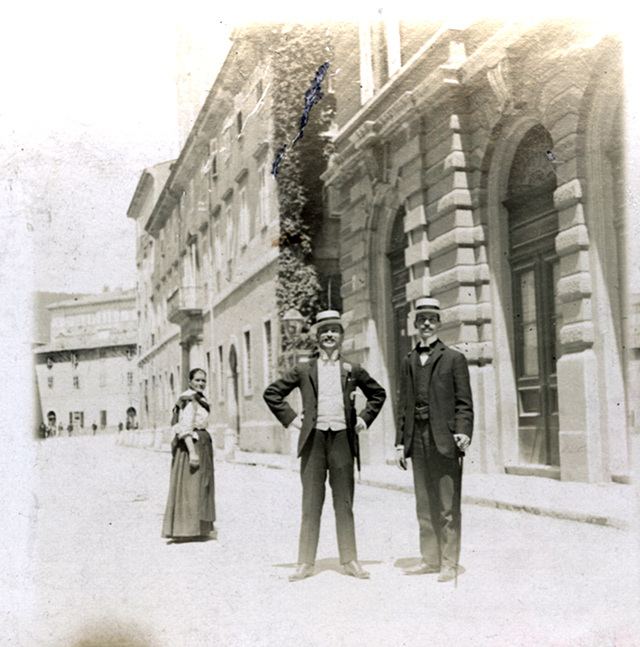
Between 1929 and 1931 Saba was treated by Edoardo Weiss, a doctor born in Trieste who introduced Sigmund Freud’s psychoanalytic theory to Italy. Saba stated that meeting Weiss marked the beginning of a new chapter in his life, when he finally realized the important role played in his life by the wet nurse, whom he contacted and visited frequently.
A child’s cry
rings out in the stairwell. a woman, leaving,
also weeps. and in that moment someone’s
heart is broken for all time.
Forty years
have passed since then.
The child
is now a man,
almost an old man, and versed
in many thing, both good and bad.
That child
is Umberto Saba.
And, in search of peace of mind,
he’s gone to talk with his wet nurse.
She too, on leaving him, felt bad or worse
than he, and did not leave him voluntarily.
– Little Berto (1929-1931) –
12. CAFFÈ MUNICIPIO (LATER GARIBALDI)
Piazza Grande 4-5
Today piazza dell’Unità d’Italia, 5
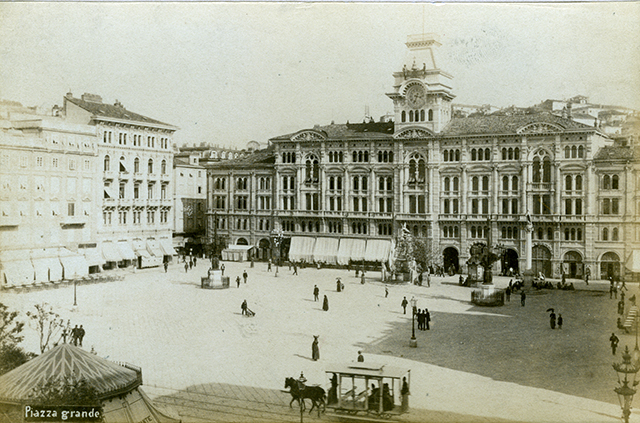
Since 1905 Saba and his friends would meet at Caffè Municipio in Piazza Grande. Here Saba met Silvio Benco, a writer, journalist and critic for the local daily “Piccolo”, who read his poems and immediately understood the originality of Saba’s work and the main themes of his poetics.
After the First World War the café was renamed Caffè Garibaldi and others joined the intellectuals who were regulars there, including the writers Svevo, Joyce, Quarantotti Gambini, Stuparich and the poet Virgilio Giotti.
13. CAFFÈ DEI NEGOZIANTI (TODAY CAFFÈ TOMMASEO)
Piazza dei Negozianti, 3
Today piazza Nicolò Tommaseo, 4C
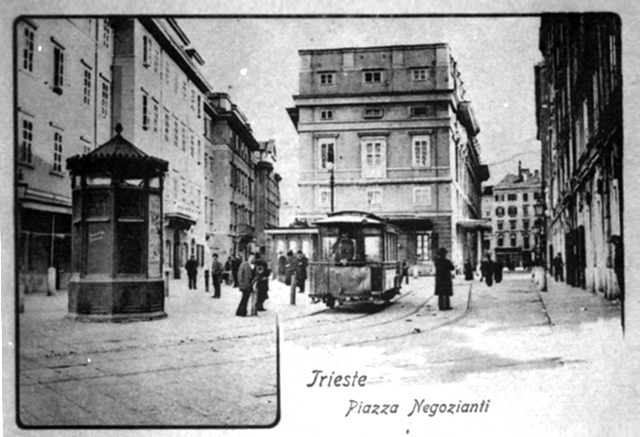
Caffè Tommaseo is one of most ancient and prestigious cafés in Trieste. It was one of the first to use gas lighting and the first to serve ice-cream. Saba himself, in a letter to his friend Nora Baldi dated 21 December 1953, recalls: “I have eaten the most delicious pistachio ice-creams, that I am afraid are found nowhere else in the vast world.” The café was the meeting place of an active group of intellectuals from Trieste’s middle class, as well as actors and singers working in the nearby Teatro Comunale (today Teatro Verdi).
You see, my heart, after so many
years spent outside of that old dream,
I now return to Caffè dei Negozianti.
– Caffè dei Negozianti (1921)
14. Biblioteca civica Attilio Hortis
Via Madonna del Mare, 13
Ph. +39 040 6758200 Fax +39 040 6758199
bibcivica@comune.trieste.it
www.bibliotecacivicahortis.it
Per la stesura dell’itinerario si è fatto riferimento anche a:
Umberto Saba: Itinerari triestini / Umberto Saba: Triestine Itineraries a cura di Renzo S. Crivelli e Elvio Guagnini MGS press, Trieste 2007

